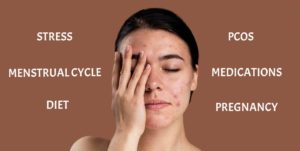Imagine a world where we could lock away acne forever, and bury it in the vault of our memories. Yet, just when we thought it was a relic of our teenage years, hormonal acne sneaks back into our lives, uninvited. It’s like an old friend from the past, only the one you’d rather not meet.
Have you ever found yourself hunched over your kitchen table like a determined witch over her bubbling cauldron, searching for the magical potion to conquer hormonal acne? Well, before we craft that spell, we need to first uncover the Hormonal Acne cause, and the trusted treatments for this skincare issue.
Let’s roll up our sleeves, dig into the nitty-gritty of hormonal acne, and figure this out together.
What is Hormonal Acne?
Let’s start with the basics. Hormonal acne is unlike your typical pimples that crop up occasionally. It’s the stubborn, recurring villain that can haunt us well into adulthood. This type of acne is often a consequence of hormonal fluctuations in the body, typically affecting women.
Research indicates that approximately 50% of adult women experience hormonal acne at some point in their lives. Hormonal acne tends to target the lower part of your face, with its favorite hangouts being the chin and jawline. However, it doesn’t limit itself to the face; it can also target the back and chest.
Hormonal Acne Causes
Hormonal acne is primarily caused by fluctuations in hormone levels, which can trigger increased oil production and clogged hair follicles. The key hormonal acne causes include:

1. Menstrual Cycle
Hormonal changes during the menstrual cycle, particularly an increase in androgens (like testosterone) just before menstruation, can stimulate oil glands and lead to breakouts.
2. Polycystic Ovary Syndrome (PCOS)
Women with PCOS often have higher levels of androgens, making them more susceptible to hormonal acne.
3. Pregnancy
Hormonal fluctuations during pregnancy can lead to acne breakouts.
4. Menopause
Menopausal women may experience hormonal shifts that trigger acne.
5. Stress
High-stress levels can exacerbate hormonal imbalances and worsen acne.
6. Diet
Consumption of a diet high in refined carbohydrates and dairy products can influence hormone levels and contribute to acne.
7. Medications
Certain medications, including corticosteroids and hormonal medications, can affect hormone levels and lead to acne as a side effect.
Hormonal Acne Treatment
Now, it’s time to build our arsenal for the battle against hormonal acne. Let’s get specific:

1. Topical Superheroes
- Benzoyl Peroxide: This over-the-counter warrior takes on acne-causing bacteria with gusto.
- Salicylic Acid: A loyal ally, it dives deep into your pores, preventing clogs and breakouts.
- Retinoids: These unclog pores and make it difficult for acne to find a foothold.
2. Oral Contraceptives
- Birth Control Pills: For women, certain birth control pills can regulate hormone levels and keep acne in check.
- Anti-Androgens: When prescribed by dermatologists, these medications take on the hormones responsible for acne.
3. The Lifestyle Overhaul
Your daily habits play a significant role:
- Stress Reduction: Engage in stress-busting activities like yoga, meditation, or simply taking time for yourself. In the hustle-bustle of life, you should not forget yourself. Treat yourself with kindness!
- Diet: Reduce sugar and dairy intake while increasing your consumption of skin-friendly foods like leafy greens and antioxidants.
4. Professional Intervention
- Chemical Peels: A visit to the dermatologist for a chemical peel can exfoliate your skin, reducing acne and blemishes.
- Light Therapy: This cutting-edge treatment uses specific wavelengths of light to target acne-causing bacteria effectively.
5. Seek Dermatological Guidance
Each person’s journey with hormonal acne is unique, and an individualized approach is crucial. A dermatologist, the expert in this field, can customize treatments and product recommendations based on your specific needs. They can identify the most effective solutions, considering factors such as your skin type, the severity of your acne, and your overall health, ensuring a good plan to fight acne!
Concluding Our Hormonal Acne Journey
Hormonal acne can be a tough opponent, but understanding its symptoms and triggers is the first step. It’s a common issue, affecting about half of adult women at some point. To win the battle, consider tailored treatments, and consult a dermatologist for a personalized plan. With the right strategies, hormonal acne causes can become a thing of the past, leaving you with clear, confident skin to face the world. The future is bright, and so is your skin!
Hormonal Acne FAQs-
What causes hormonal acne?
Hormonal imbalances, often tied to the menstrual cycle or conditions like PCOS, trigger hormonal acne.
What should I do if I suspect I have hormonal acne?
Consult a dermatologist for a personalized treatment plan tailored to your specific needs.
Can men experience hormonal acne?
While less common, men can also experience hormonal acne due to hormone imbalances.
Are there home remedies for hormonal acne?
Some home remedies like using tea tree oil or applying a honey mask may offer mild relief, but consulting a dermatologist for tailored treatments is often more effective.


Pingback: Why is Shea Butter Used in Skincare? Discover Benefits and Usage - Wild Oak Skincare
Pingback: Does Micellar Water Benefit the Skin? Discover Purpose and Usage - Wild Oak Skincare